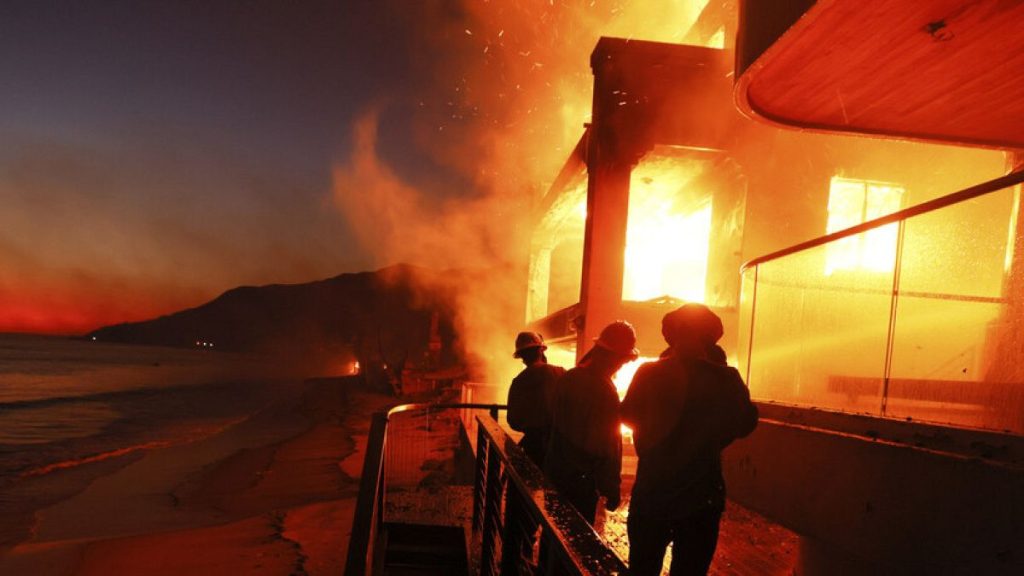The Los Angeles County grappled with a devastating series of wildfires, with at least five confirmed fatalities and the grim expectation of a rising death toll. Six separate fires raged across the region, consuming vast stretches of picturesque landscape and leaving a trail of destruction in their wake. While a slight easing of wind conditions and the arrival of reinforcements from across the state initially offered a glimmer of hope, the situation remained volatile and dangerous, punctuated by the eruption of a new fire in the Hollywood Hills. This latest outbreak triggered mandatory evacuations, expanding the existing evacuation zones to encompass areas of Santa Monica, further displacing thousands of residents.
The scale of the disaster was staggering. Over 1,000 structures, primarily residential homes, were reduced to rubble. The number of evacuees fluctuated as new fires ignited, but remained in the vicinity of 130,000 individuals across the metropolitan area. A thick, acrid smoke blanketed much of Los Angeles, obscuring the skyline and creating hazardous air quality conditions. The fires also inflicted damage on the city’s educational infrastructure, with at least seven schools either damaged or destroyed. Los Angeles Mayor Karen Bass confirmed the deployment of firefighting units and aerial resources from across California, bolstering the local response efforts.
Despite the calmer winds compared to the previous evening’s hurricane-force gusts, Mayor Bass cautioned that the erratic nature of the wind patterns posed a significant challenge, accelerating the spread of the flames. In Pasadena, one of the hardest-hit areas, Fire Chief Chad Augustin estimated that between 200 and 500 structures were damaged or destroyed by the Eaton fire, which ignited Tuesday night, fueled by the ferocious winds. Along the Pacific Coast, west of downtown Los Angeles, the Pacific Palisades fire carved a devastating path, leveling entire city blocks and leaving a landscape of charred debris. Authorities estimated that over 1,000 structures were consumed by this fire alone, making it the most destructive wildfire in Los Angeles’ modern history.
Harrowing images captured the extent of the devastation: luxurious homes reduced to ashes, swimming pools blackened with soot, and expensive sports cars slumped on melted tires. The affluent Pacific Palisades neighborhood, a haven for celebrities and high-profile individuals, bore the brunt of the fire’s fury. Many of Hollywood’s elite were forced to flee their homes, while others, including Adam Brody and Leighton Meester, lost their residences entirely. Paris Hilton’s Malibu beachfront property also succumbed to the flames. LA County Supervisor Lindsey Horvath eloquently captured the collective sense of loss and despair: “This morning, we woke up to a dark cloud over all of Los Angeles. But it is darkest for those who are most intimately impacted by these fires. It has been an immensely painful 24 hours.”
The pervasive smoke and ash created hazardous air quality across multiple areas of Los Angeles, prompting authorities to issue health advisories. Residents were urged to remain indoors, limit strenuous physical activity, and closely monitor official updates and evacuation orders. The fires, which consumed approximately 22 square miles (57 square kilometers) within a single day, cast a long shadow over the region, with smoke and ash drifting far beyond Los Angeles County, impacting communities to the east and south. The full extent of the damage and the long-term consequences of this devastating wildfire event are yet to be fully realized.
The wildfires represent a stark reminder of the vulnerability of communities, even affluent ones, to the destructive power of nature. The confluence of strong winds, dry vegetation, and challenging terrain created a perfect storm for rapid fire spread. The scenes of devastation in the Pacific Palisades, a symbol of luxury and exclusivity, underscore the indiscriminate nature of such disasters. As the firefighting efforts continue and the recovery process begins, the focus will shift to assessing the full extent of the damage, providing support to displaced residents, and implementing measures to mitigate the risk of future wildfires. The emotional scars left by this catastrophic event, however, will likely linger for years to come.














